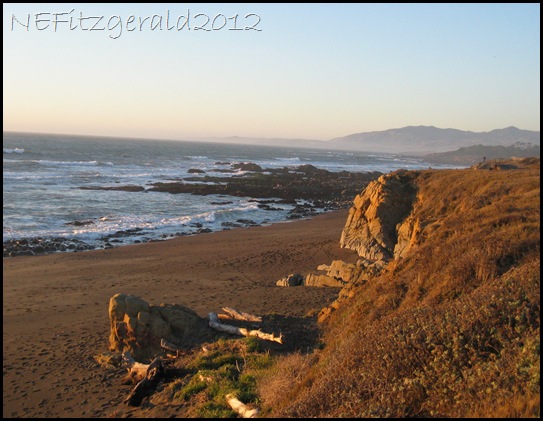Since there are so many unique destinations in the world, and so many intriguing places to visit, why on earth would anyone want to return to anywhere?
If you have ever visited Moonstone Beach, California, you would know the answer to this question.
 |
| Moonstone Beach, California |
I find this rocky stretch of central California coastline so downright appealing that I have gladly endured the eleven hour rump–numbing drive either to or from southern Utah not once but twice. The first was in September 2003 when I invited my dear old Dad along for a week at a small inn overlooking the blue Pacific. According to the proprietor, autumn is a good time of year to visit the central coast because the ocean fog is not as prevalent as it is during summer.
In 2007 I was on my way home alone from San Diego during the Christmas holidays and went 350 miles out of my way to spend three nights at another small inn on the beach. Both times were off–season, both times were special, and I would most definitely go there again. At the halfway point between Los Angeles and San Francisco, it is light years away from the frantic pace of either.
 |
| Evening along Moonstone Beach |
The picturesque village of nearby Cambria is certainly worth a few hours of one’s time if only for the various wine-tasting rooms – this is the central coast wine region, after all. It is the beach, though, that beckons me and holds me in its many moods like a starfish in an endlessly shifting tide pool. A weathered wooden boardwalk edged here and there by twisted Monterey pines weaves a path along the shrub–covered shoreline for nearly a mile. There are side pathways veering off to hidden rocky crevasses, and weather–worn steps give steep access down to the water and a closer look at its tide pool inhabitants. It is easy to pause on a rustic split–log bench, losing oneself in the echo of waves crashing on the rocks and the brilliance of an immense gentian blue that is the Pacific Ocean sky.
 |
| Moonstone Beach boardwalk |
 |
| Stop and sit a spell… |
 |
| Steps take visitors down onto the beach |
Why the name Moonstone?
It is said that the ancient Greeks used the term “moonstone” to describe those gems that evoke the moon’s delicate, ethereal light. Not everything named “moonstone” is actually the same thing, though. There are gem–quality stones that are a type of the mineral feldspar, and there is Moonstone Beach moonstone that is apparently chalcedony, a microcrystalline quartz in which the crystals are so small they can only be seen under a microscope. A fine distinction, but there it is.
Feldspars are a group of common rock–forming minerals that make up as much as 60% of the Earth’s crust. There is a whole lot of variation in them, depending on the ratio of the major elements (sodium, potassium, calcium, aluminum, silicon, and oxygen) present in the feldspar itself. This can be compared in a general way to the ratios along a visible light spectrum – how much yellow and blue does it take to make green? Similarly, how much of each specific element does it take to create moonstone?

Gem–quality moonstone is an opalescent variety of orthoclase feldspar called adularia. It exhibits a milky iridescence like opal and contains potassium but no sodium in its chemical structure. It displays a distinctive blue or white internal play of color caused by finely alternating layers of these different ends of the feldspar spectrum.
 |
| image courtesy gemsociety.org |
Chalcedony, on the other hand, is not gem–quality. It is a microcrystalline version of quartz, one of the most common minerals on earth. There is no sodium, potassium, calcium, or aluminum present as there would be in feldspar. Interestingly, chalcedony often develops as a dehydration product of opal, itself a hydrated quartz. The physical similarities in the play of light in chalcedony when compared to adularia are the reason it continues to be referred to as moonstone.
 |
| Moonstone pebbles from Moonstone Beach – image courtesy moonstones.com |
The gemstone that is usually cut as a cabochon and used in jewelry is found all over the world but primarily in Sri Lanka and India. There are quite a few shops in Cambria that sell moonstone jewelry but I always resist the temptation to lighten my wallet by purchasing anything. Wine tasting rooms, however, are another story completely.
 |
| What a fun five hours that was – getting a good wine buzz with total strangers! |
Moonstone’s presence on this central California beach is the reason you often find, at low tide, people walking slowly up and down the shoreline, bent over to look closely here and there as they search for the distinctive pebbles. Once you learn what they look like it becomes quite easy to spot them.
 |
| Looking for moonstones |
Not knowing much about California geology in these parts except that it is west of the San Andreas Fault and so is sailing towards Alaska on the eastern edge of the Pacific plate, I figure that the moonstone/chalcedony crystals would have originated in the Central Coast Range mountains to the east between Paso Robles and Cambria. On their relatively short journey to the water’s edge, any jaggedness would be eventually smoothed down, the crystals tumbled relentlessly over and over until they became the softly rounded pebbles being tossed about by the surf breaking on Moonstone Beach.
 |






